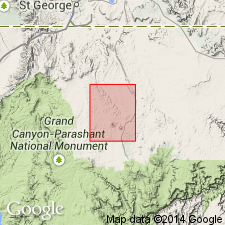
- Usage in publication:
-
- Moriah Knoll Basalt*
- Modifications:
-
- Named
- Geochronologic dating
- Mapped
- Dominant lithology:
-
- Basalt
- AAPG geologic province:
-
- Plateau sedimentary province
Summary:
Named for Moriah Knoll, a cinder cone volcano, which is designated the type area and is located in secs 12,13, T37N, Rs 8,9W (USGS Moriah Knoll 7.5' quad), about 1.5 km east of east-central edge of map area, northern Mohave Co, northwestern AZ, Plateau sedimentary province. Within map area unit consists of one 3 m-thick flow in secs 27,34, T38N, R9W. Consists of black, aphanitic, vesicular basalt; includes scattered olivine crystals; vesicles commonly calcite filled. Basalt occupies a shallow, minor, north-trending drainage east of Hurricane Fault. Unit overrode thin alluvial deposits and Harrisburg and Fossil Mountain Members of Kaibab Formation. Younger than newly named Diamond Butte Basalt (Pliocene); older than newly named Little Tanks Basalt (Pleistocene). K-Ar whole-rock age is 2.3 +/-1.5 Ma, however, age considered to be unreliable due to excessive alteration and contamination of sample (Harold Mehnert, 1993, USGS, written commun.). Considered to be Pleistocene age because of relationship to other nearby Pleistocene basalt flows near Clayhole Wash, about 6 km east of map area.
Source: GNU records (USGS DDS-6; Denver GNULEX).
For more information, please contact Nancy Stamm, Geologic Names Committee Secretary.
Asterisk (*) indicates published by U.S. Geological Survey authors.
"No current usage" (†) implies that a name has been abandoned or has fallen into disuse. Former usage and, if known, replacement name given in parentheses ( ).
Slash (/) indicates name conflicts with nomenclatural guidelines (CSN, 1933; ACSN, 1961, 1970; NACSN, 1983, 2005, 2021). May be explained within brackets ([ ]).

